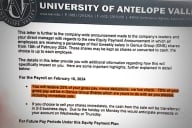You have /5 articles left.
Sign up for a free account or log in.
For students looking to learn skills and land jobs, might the good word of a highly regarded instructor count as much as the imprimatur of a highly regarded institution?
The question arose in the fall, when a handful of professors at Stanford University decided to teach free courses online to tens of thousands of students who were not enrolled at the elite California university. The students would receive no Stanford credit; only a signed letter by the instructor, acting apart from the university.
The pair of part-time Stanford instructors who co-taught the most successful of the open courses, on artificial intelligence, now intend to put the importance of the institutional brand to the test. They are co-founders of a company that will offer two similarly “open” courses beginning in February, this time independently of the Stanford name.
The company, called Know Labs, has funding from Charles River Ventures and aspires to be a for-profit enterprise that offers high-quality college courses on the cheap to tens of thousands of students at a time through an online learning portal called Udacity.
Meanwhile, other members of the Stanford computer science department, several of whom also broadcast open versions of their courses to global audiences in the fall, are also looking to expand and formalize their efforts. This parallel effort, led by professors Daphne Koller and Andrew Ng, has not decided whether to spin off a company or nonprofit organization of their own. But they are considering their options, according to Koller. “There are obviously many options in how to structure this,” says Koller. “We’re exploring different ideas.… Anything’s possible.”
The Know Labs project is further along. One of the Stanford adjuncts, Sebastian Thrun, will teach a course based on his work as the head of Google’s effort to build self-driving cars. David Evans, an associate professor of computer science at the University of Virginia, will teach an introductory course in computer sciences centered on the architecture of Web search engines. Both courses will be free as the young company, flush with an undisclosed amount of investment capital, figures out its business model.
Like the artificial intelligence course he taught in the fall with his Google colleague Peter Norvig, Thrun’s “Build Your Own Robotic Car” course will require prior knowledge of some mathematical and engineering concepts. Evans’s “Build Your Own Search Engine” course, however, will be “targeted to students with no background” in computer science, the Virginia professor says. (Evans is taking a year from his tenured post at Virginia to serve as Know Labs’ vice president for education.)
“The goal is to have a course that anyone who is willing to put in the effort will be able to take,” says Evans. He added that he is hoping the introductory course will provide a foundation for subsequent courses that follow some curricular logic. “The goal,” he says, “is to have a sequence of courses that would be comparable to a top university degree.” Whether the students will collect a credential that employers and other institutions recognize and respect, however, is a different question altogether.
The Credibility Question
The education-technology world buzzed last fall when Stanford became the first elite institution to offer massively open online courses, or MOOCs. One course in particular, an advanced online class in artificial intelligence, attracted a whopping 160,000 enrollees -- 20,000 of whom stuck with it and completed all the coursework.
Many hailed Stanford for throwing open the gates to its coveted curriculum to an unprecedented degree. But despite Stanford’s moral and material support to the instructors experimenting with MOOCs (it supplied support staff, discretionary funding and equipment), the university refused to formally recognize the achievements of the non-Stanford students -- even those who scored on par with their tuition-paying counterparts in Palo Alto.
Instead, the students each got a letter with their grade and class rank, signed by the professors. No Stanford seal, just the professor’s name and signature. “It raises the question: Whose certification matters, for what purposes?” Michael Feldstein, a widely read educational technology blogger, told Inside Higher Ed at the time. “If individual professors can begin to certify student competence, [then] that begins to unravel the entire fabric of the institution itself.”
The artificial intelligence course got a big boost in credibility -- and quite possibly in enrollment -- from its nominal connection to Stanford. Can a start-up company, obscure but for the afterglow of the “Stanford open courses," expect to attract the same level of interest?
“The answer is, I don’t know,” says David Stavens, the CEO and co-founder of Know Labs. “I’ll tell you for sure two weeks from now when we look at the enrollment numbers for these courses.”
But Stavens says informal surveys of the participants in the artificial intelligence pilot give him and his colleagues cause for hope.
“One of the things we asked was, 'Which is more important to you -- the reputation of the instructor, or the reputation of the institution?' ” says Stavens.
“They said the instructor is the main thing that’s important to them,” he says. “That gives us a lot of running room.”
Down to Business
Despite the shorthand used by observers and journalists (including yours truly), Thrun and Norvig’s artificial intelligence course was never a Stanford University venture. In June 2011, Stavens finished a doctorate in computer science at Stanford; two weeks later, he co-founded Know Labs with Thrun, who was his thesis adviser, and Michael Sokolsky, a robotics research engineer at Stanford who has since resigned from the university.
The artificial intelligence MOOC that Thrun and Norvig taught in the fall was intended as a proof-of-concept for Know Labs’ course-delivery model, Stavens says. Its success helped Know Labs secure a “very serious, sizable” investment from Charles River Ventures in December.
Stanford has no investment in Know Labs or Udacity, according to Lisa Lapin, assistant vice president for communications at the university. The course’s website was hosted on a non-Stanford server, says Lapin, although its website did bear the seal of the Stanford Engineering school. The video tutorials Thrun and Norvig posted there were made outside of class, using an overhead camera looking down at the instructor’s hand working through problems longhand on a sheet of paper while narrating -- a sort of analog version of Salman Khan’s digital screencasts.
“We have not entered into any exclusive arrangements related to commercialization,” Lapin wrote in a statement. “And we have not granted permission for use of the Stanford name by any external entities.”
Know Labs asked Stanford if Thrun and Norvig could use video captures of their classroom lectures, but the university said no, according to Stavens. (Lapin could not immediately confirm this.)
In any case, that is in the past. The company has moved on to developing new courses exclusively for the Udacity portal. Stavens says he and his colleagues are not committed to any particular path; he says Udacity could eventually seek to have its courses certified by third-party auditors so that other colleges might accept them for transfer credit, and has not ruled out institutional accreditation down the line.
But wriggling into the mainstream of the U.S. higher education system is not an urgent priority, says Stavens. The enrollment scale that the company believes it can achieve means that even if Udacity begins charging students to take its courses, the per-student fees would be vanishingly small. At present, a course of 160,000 students could cover its overhead by charging $1 per student, Stavens says. With costs that well-distributed, Udacity need not worry about whether its students qualify for federal financial aid -- the lifeblood of most degree-granting for-profits.
There are other business models that might allow Udacity to continue offering its courses free of charge. One possibility would be to double as a recruiting agency for tech companies and engineering firms, says Stavens. Rather than granting credentials that students might use to impress employers, Udacity could cut to the chase by headhunting within its student body on behalf of companies, matching students to jobs and collecting recruiting fees. That way, Udacity would have an immediate, tangible incentive to turn out skilled “graduates,” Stavens says.
“If we only ever get paid when our students get the best job,” he says, “I think that really aligns our interests with the interests of our students in a [concrete] way.”
Case in point: Know Labs seems to be skimming the cream of its first crop of students in hope of filling vacancies on its own staff. In December, Thrun sent an e-mail to the top performers in the artificial intelligence course, inviting them to apply for openings at Know Labs.
“We really see this new online class not just as a means to offer free education, but also as a way for some of our most talented students to find new, better jobs,” Thrun wrote. “You are among the top 1,000 students right now -- which is amazing. Based on your performance in this class, you are of the caliber that tech companies here really want.”
For the latest technology news and opinion from Inside Higher Ed, follow @IHEtech on Twitter.








